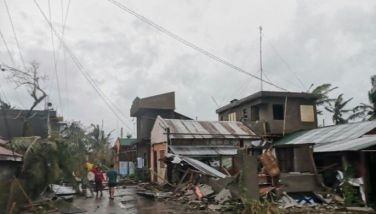17 years to a peace deal
MANILA, Philippines - What the government and the Moro Islamic Liberation Front (MILF) started on Jan. 7, 1997 in Barangay Simuay in Sultan Kudarat town, Maguindanao, culminated in the signing of a peace agreement that took both sides 17 years to draft.
The talks have had many ups and downs, to the point of collapse many times over, with negotiators restarting each time to find a lasting solution to the nagging “Moro issue,†or the quest of Mindanao’s Muslim communities for self-rule under the international right-to-self-determination doctrine.
The peace talks between the government and the MILF started three months after the Sept. 2, 1996 final peace agreement with the Moro National Liberation Front (MNLF).
The MILF was borne out of the MNLF.
The founding chairman of the then monolithic MNLF, Nur Misuari, was quick to complain about Malacañang having started the peace talks with the MILF barely three months after signing the final peace accord brokered by the Organization of Islamic Cooperation (OIC), at the time called Organization of the Islamic Conference.
“The ink of the pen we used in signing the final peace agreement between the government and the MNLF has not even dried, here comes another peace effort with another group,†a ranting Misuari then said.
Misuari, who hails from Sulu, has a deep-seated animosity for the MILF, sparked by his ideological differences with its founding chairman, the late Egyptian-trained Salamat Hashim, an ethnic Maguindanaon.
As young comrades full of idealism, Misuari and Salamat helped each other organize the MNLF in the early 1970s.
They had a falling out in 1979 due to political differences that ushered in the birth of the Salamat-led, more secular MILF.
With senior ethnic Maguindanaon members of the MNLF on his side, Salamat bolted from the group, launched the MILF in the early 1980s, and established base at Tugaig area in Barira town in Maguindanao, which was to become Camp Abubakar Assidik, the group’s first ever bastion in Mindanao.
It was in Camp Abubakar, located at the tri-boundary of Maguindanao’s adjoining Barira, Buldon and Matanog towns, where Salamat had showcased his concept of a puritan Islamic community, governed by Sharia and the Islamic principle of oneness of religion and governance.
The “Mindanao conflict,†in contemporary history, began with pockets of hostilities between Moro gunmen belonging to the so-called Mindanao Independence Movement and government security forces in Kabayuan district in Buldon in what is now Maguindanao province in the early 1970s, before the outbreak of the full-blown MNLF uprising in 1974 in Sulu, now a component province of the Autonomous Region in Muslim Mindanao (ARMM).
The conflict in Buldon and nearby areas was followed by the simultaneous attacks on Oct. 21, 1972 at strategic areas in Marawi City, including the campus of the state-run Mindanao State University (MSU), by Maranaws armed with vintage World War II rifles.
The armed Maranaws took over the government’s radio station dxSO inside the MSU campus, aired martial songs, and repeatedly called on Muslims to rise against the government and fight for Mindanao independence.
Massive destruction
Poverty and underdevelopment in many flashpoint areas covered by the 1997 Agreement on General Cessation of Hostilities between the government and the MILF worsened during the first 11 of the shaky 17 years of peace talks.
The negotiations first collapsed on April 30, 2000 when then President Joseph Estrada declared an all- out war against the MILF in a military adventurism that displaced about a million Mindanao residents.
Estrada himself, dressed in battle fatigues, led soldiers in celebrating the fall of Camp Abubakar on June 10, 2000, as a result of his campaign to drive away MILF rebels from all of their supposedly recognized 44 “main and minor camps†scattered across mainland Mindanao.
The peace talks again hit a snag when government forces took over the MILF’s last frontier, the Buliok complex at the border of Pagalungan, Maguindanao and North Cotabato’s Pikit town in February 2003, under the pretext of a calibrated police action meant to flush out kidnappers from the 3,000-hectare guerrilla enclave.
Hundreds of villages in the three provinces were again ravaged when more military-MILF hostilities ensued after the aborted Aug. 5, 2008 signing in Malaysia of the Memorandum of Agreement on Ancestral Domain (MOA-AD).
The botched MOA-AD was the supposed, first ever basis for the creation of a Bangsamoro homeland in Southern Mindanao.
The Supreme Court restrained the government and the MILF from signing the MOA-AD on the behest of influential groups, among them blocks of Mindanao politicians hostile to the peace talks. The high tribunal eventually declared the document unconstitutional.
“This time we are witnessing the dawning of a new chapter in the history of Mindanao’s Bangsamoro community,†said Bobby Benito, director of the Mindanao Human Rights Action Center, referring to yesterday’s signing of the CAB by the government and the MILF.
- Latest
- Trending


























